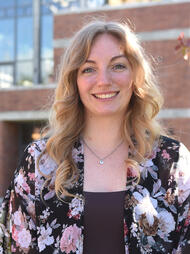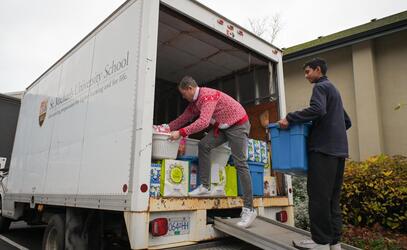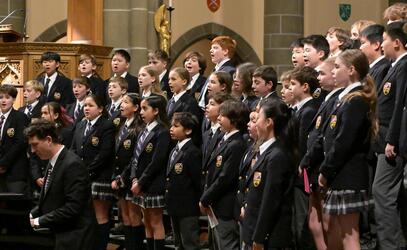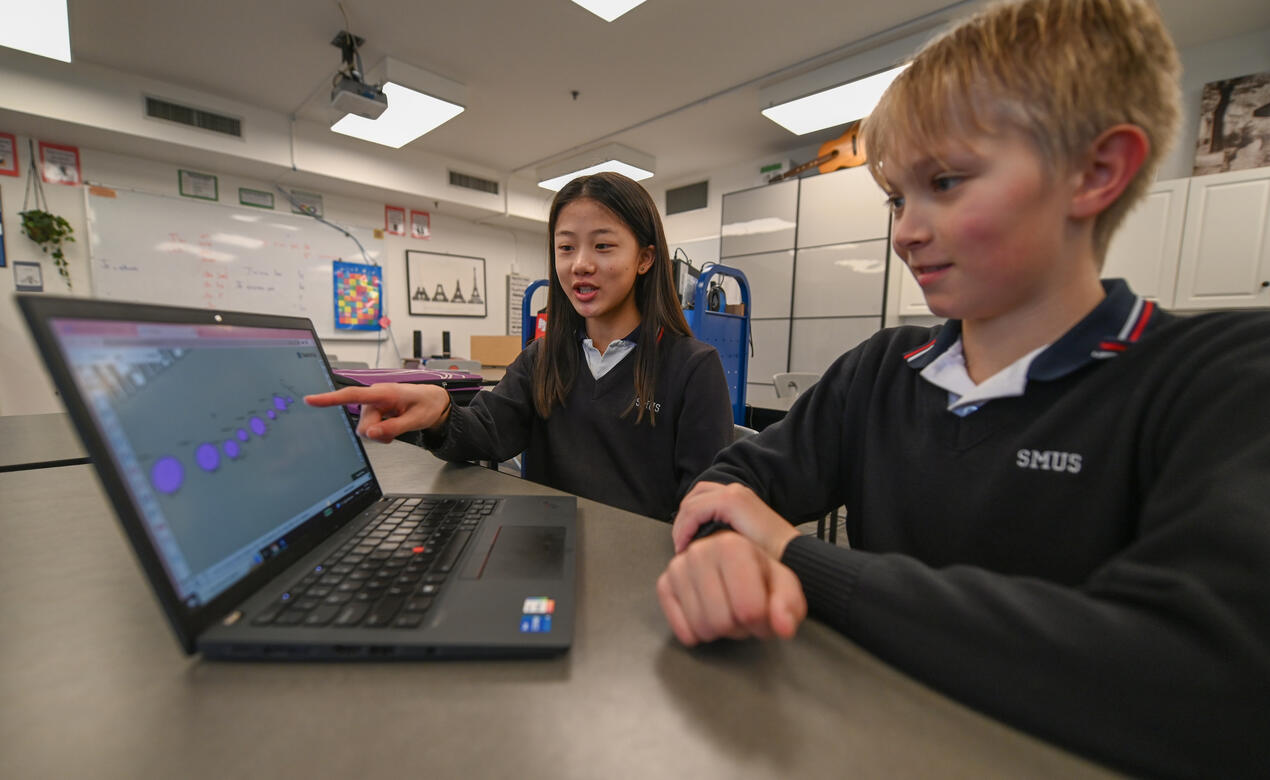
“STEM”—Science, Technology, Engineering, and Math—was first coined in 2001, as part of a campaign to re-engage students in disciplines that were seeing a decrease in participation at the time. In the more than 20 years since, society has experienced the development of 3D printers, digital design, Artificial Intelligence (AI), and more, paving the way for a new discipline to be added to the term: Art. More specifically, Applied Design, Skills, and Technology (ADST), a key course at SMUS that has transitioned the acronym to STEAM, which seeks to include these revolutionary art-based technologies in its teachings.
“STEAM takes STEM to another level,” says Denise Lamarche, Director of Academics. “It focuses on sparking imagination and creativity through the arts in ways that naturally align with STEM learning, drawing upon and connecting interdisciplinary perspectives, creativity, and technology for guiding inquiry, problem solving and critical thinking.” These skills transfer to classes and situations outside of STEAM too, allowing students to excel in a variety of fields.
Between the Junior School’s Imagination Lab, 3D printers and ADST class at the Middle School, and chemistry experiments and unique clubs like robotics and rocketry at the Senior School, SMUS students have been able to excel in various core and emerging STEAM subjects—and changed how they approach non-STEAM concepts as well.
Opportunities for Everyone
Tommy Eaton first discovered his interest in STEAM when he was able to make the most of the plethora of electives offered at the Senior School. This year, the Grade 10 student’s course load includes biology, physics, chemistry, science expansion, pre-calculus, engineering and design, robotics, and more. “I like the feeling of finding the right answer in Chemistry and Math, and how you can build your own solutions to different sorts of problems in Engineering and Design.”
If he had to pick his favourites though, he’d say physics and chemistry. “Learning about the rules of the universe is really cool, and I just think it’s wild how you can take a reactive metal, and an otherwise deadly gas, and turn it into something you season your steak with.
Working with my hands is what makes me so interested in it all, whether that’s (safely and intentionally) setting our hands on fire in Chemistry, or creating prosthetic prototypes in Engineering class that can help wearers do fine motor skill tasks like zipping up jackets. Problem solving is an important life skill to have, and it helps me look at challenges in my non-STEAM classes like creative writing and filmmaking differently, too. The best part about STEAM at the school are the teachers, like Mr. Csaky, Mr. Shaw, and Mr. Donatelli. They make the courses really engaging.”
Christopher Csaky, the Engineering and Design teacher at the Senior School, determines the projects intentionally. “Our students are open to challenges and hard work and have excellent communication skills and strong ability and desire to work together as teams to achieve great things. In my classes, we use these strengths to achieve excellent and highly technical and creative projects to find solutions to real-world problems. In my view, it’s the students at SMUS that make the STEAM program so exciting.”
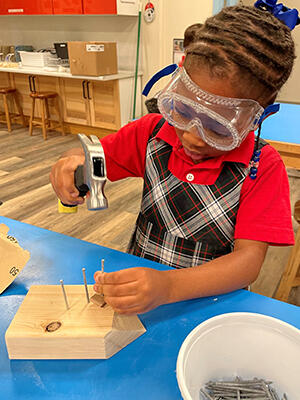
Bringing Ideas to Life
At the Junior School, the Imagination Lab (also known as the “iLab”) is a makerspace where students come to tinker and bring their ideas to life using a range of tools, technologies and materials. “Time in the iLab promotes a maker mindset,” says coordinator Leigh Johnson. “Not only is it really fun to tinker and create things in the iLab, it helps to build the creative confidence and stamina to try something new, fail, and try again. We want to build students’ familiarity with a wide range of tools, technologies and materials.”
The ADST class assignments are tailored to the needs, interests, and abilities of various grade levels throughout the day. “Having the iLab for Junior School students lays a strong foundation for Middle and Senior School opportunities, by creating plenty of STEAM-related learning opportunities during classes and extracurricular clubs the space also hosts, like LEGO Robotics Club, and Sewing Club.”
Michaela Y. has been able to take her Junior School experiences in the iLab, and build on them throughout her time at the Middle School. As a Grade 8 student currently enrolled in Computer Science and ADST, along with other sciences, she’s been learning how to use video editing platforms such as Wevideo, open-source graphics editors like Inkscape, and 3D modeling software like SketchUp.
“What makes me most excited about using these tools is that a lot of the stuff we learn in Computer Science and ADST ties into other classes too. I’ve used Wevideo to create and edit a video about climate change. Last year we did a ‘create your own civilization’ project in humanities class, and we used Inkscape to create a model for that civilization’s artifact. Then we put it into the cardboard laser cutter in the art room and got to actually create it,” she explains. “For the upcoming science fair, I’m doing my project on ‘the five-second rule’, and I’m thinking about using SketchUp to help measure the amount of bacteria that grows on the petri dish. Sketchup is helpful to measure area and volume in math class, too. There are a lot of classes that use STEAM skills, and things outside class too.”
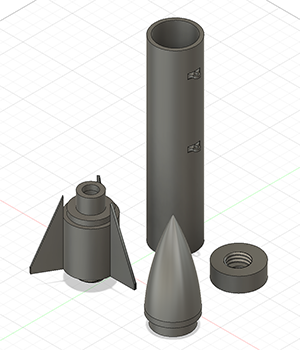
Beyond the Classroom
Taking these skills, curiosities, and passions beyond class time is exactly what Grade 11 student Brady Hsu has done, who is a senior member of the Robotics Club, and head of the Rocketry Club at Senior School. Part of SMUS’s “Friction” robotics team that won the Design Award at the provincial championships last year, he is a keen innovator and leader for his peers—so much so, that he helped teach the Grade 10 Engineering class with Mr. Csaky’s guidance and support.
Building off of his hunger for knowledge and interest in robotics, he decided to lead a Rocketry Club on campus. “It’s not the official description, but I like to say that in Rocketry Club, ‘we play with explosives and make things fly’. Really, we’re using the school’s Fusion 360 computer modelling license, and the 3D printers in ADST, to actually build the rockets. We launch them, see what works and what doesn’t, and then model and print it again with the changes. There are so many opportunities here to get involved in whatever you’re interested in.”
Soie Liao-Briere was recently featured in Chek News for her involvement in the Victoria Hand Project, assembling prosthetic limbs for amputees worldwide and fundraising for Ukraine. The Grade 12 student credits her keen interest in STEAM at SMUS for being able to participate in such an endeavor. “Last year, every single one of my classes were STEAM, except for English,” she describes. “I’m applying for universities in Canada and abroad right now. I’d like to go into Pharmaceutical Sciences, it’s like chemistry with a little bit of bio. After my undergrad, I’m thinking about going into medicine… it would be interesting to do physical chemistry, working with the actual drugs hands-on.”
Despite her STEAM-focus, she’s also a polyglot and avid musician, speaking 3 languages and playing piano. “Analytical courses like STEAM are very detail oriented, you have to ask a lot of questions so that you understand what you’re doing, which transfers over to arts and english courses really well. And, creative classes give you a different perspective and flexibility when you’re problem solving in STEAM classes.”
Nurturing STEAM at SMUS
STEAM plays a vital role in preparing students for life throughout their educational journey, including after graduation. The school has dedicated resources to exploring and enhancing the profile of the program at SMUS, including a group of teachers and administrators that visited 33 other schools last year to research how other programs and institutions are developing STEAM.
“At SMUS, there is a focus on experiential, hands-on learning in order to push creative and critical thinking, incorporate design, collaboration, and use advanced technologies as part of the learning process. We are always considering where the interdisciplinary opportunities lie as part of the planning process as well,” explains Denise Lamarche.
Planning for a STEAM-based facility at the Middle School is well underway and SMUS is also committed to creating a new STEAM-centred facility at the Senior School. These new facilities would accommodate currently popular programs like Robotics, Engineering, Computer and Graphic Design, and future areas of interest and extracurriculars such as Biochemistry, Environmental Sustainability, Data Science, and Quantum Mechanics. Learn more about these exciting projects as part of our Campus Master Plan.
